Visuals are processed 60,000x faster than text. Infographics help small businesses share ideas that are seen and remembered.
Infographics are strong visual communication tools that can simplify difficult ideas, quickly grab attention, and create a long-term impact. The visuals let you present your narrative in a style your audience likes and prefers, whether you want to increase brand recognition or make an impact with your content marketing strategy.
They can increase shareability and online reach in a short time. Creating branded infographics makes it easier to build trust and position your business as an authority. With the right design and strategy, they can become one of your most valuable content assets.
Let’s discuss in detail why infographics should be a part of your small business marketing plan.
Types of Infographics for Small Businesses
Infographics are visual presentations of information, data, or knowledge that can be consumed quickly. Large chunks of text, for instance, can be broken down into bite-sized content like carousels or a single image featuring the key points.
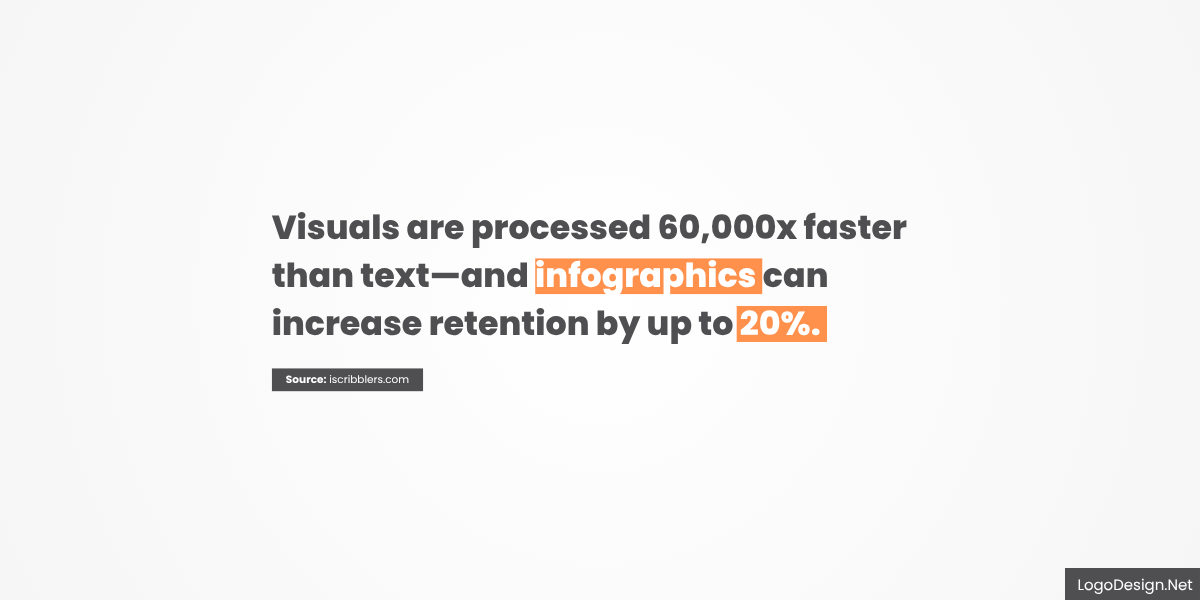
This image shows the statistics about infographics being easier to process than text
Small firms can use them as a strong communication tool, combining text, symbols, graphs, and drawings to convey an engaging and easy-to-understand message. Instead of putting out content for viewers in long paragraphs or complex data sets, you could consider infographics. This format simplifies content to grab focus and stay in memory for a long time.
• Statistical Infographics

This is a statistical infographic that highlights the number in a larger font
These showcase numbers, data points, and charts in a visually appealing format. Great for highlighting industry trends, research results, or performance metrics.
• Informational Infographics

This is an informational infographic to catch the viewers attention when they are scrolling
Ideal for presenting concepts or overviews. Use them to explain your services, brand values, or customer benefits clearly and concisely.
• Timeline Infographics

This timeline infographic illustrates events happening at various times
These display information chronologically, making them perfect for showing your company’s history, product development timeline, or step-by-step process.
• Process Infographics

This process infographic highlight different steps in a certain process
Help break down workflows or procedures into simple steps. Useful for onboarding, tutorials, or showing how your service works.
• Comparison Infographics

This image of a comparison infographic helps highlight how both objects are different
These highlight the differences between two or more options. Use them to compare product features, service packages, or industry alternatives.
• List-Based Infographics

This image of list based infographic helps generate a list of items
Present ideas, tips, or resources in a list format. Ideal for social sharing and bite-sized content.
• Geographic Infographics

The image is a geographic infographic to show location-based statistics and data.
Use maps or location-based data to show regional statistics, market reach, or customer demographics.
• Interactive Infographics (advanced)

This is an interactive infographic that changes dynamically, keeping the viewer engaged
These involve clickable elements or animation and are great for web experiences, although they require more development. For your professional business website, you can incorporate such visuals seamlessly.
Each type of infographic serves a specific purpose, and choosing the right format depends on the message you want to communicate and how your audience consumes content. When integrated into your marketing strategy, infographics can clarify your message while enhancing your brand’s professional appeal.
How to Create Visually Impactful Infographics
Creating good infographics involves more than simply combining colors and icons. It is about transforming complex data into visually appealing content that communicates clearly and effectively. Just think of how often you have stopped scrolling on a website or social media page to look at statistics or information presented with visuals.
To grab attention in seconds, small businesses need to focus on designing infographics that connect with the target audience and help them achieve their marketing goals. To help you understand this in-depth, here are the key factors to keep in mind.
1. Establish a Clear and Strategic Goal
Every infographic ought to serve a noted goal. Before you start designing, consider what action you want your audience to take after viewing this. Are you trying to simplify a service process, explain a product, build authority with data, or create backlinks via shareable content? Answer these questions before getting started on your designs.
Moreover, to get started, try using an AI text summarizer to quickly extract the core message from longer content. It helps you focus on the most important points, so your infographic stays clear, aligned with your goal, and easy for your audience to understand.
2. Structure and Organize your Material
Begin with a rough draft of your main ideas and organize them into groups. Infographics should allow for a natural information flow, whether top-to-bottom, left-to-right, or divided into sections. Divide the message into bite-sized pieces using headlines, subpoints, and brief text blocks.
3. Use Visual hierarchy for Direction
Visual hierarchy is the technique of determining the sequence in which information is processed by the human eye. Emphasize the most important information like numbers, major takeaways, or section titles. Use bigger fonts, bold colors, a versatile logo, and opposing elements. Arrange your design such the eye naturally follows a sensible path. White space helps to highlight every component and stops mess; it is equally crucial. A flawless reading experience that promotes complete involvement is the aim of this design.
4. Follow the Brand Style Guide
Infographics serve as a branding tool, not only as a content item. This is why maintaining consistency with the visual identity of your brand is so important. Maintain the design in line with your general image by using your business logos, brand colors, typeface, and tone of voice. An infographic with good branding raises brand recognition, professionalism, and trust. Should someone share it, viewers should immediately identify it as the work of your company, even without seeing your name.
5. Use DIY tools or Hire Professionals
Look for design tools that can help you create infographics if you are short on time. Otherwise, you can always hire a professional to get visually impactful designs that are on brand as well. See it as an investment in marketing materials that continuously yield shares, backlinks, and user interaction.
6. Create for Multi-Platform Use and Shareability
Infographics shouldn’t be limited to a single application. Consider how you might reuse or resize them for blog entries, social media, newsletters, or perhaps print material when planning. Vertical designs shine on blogs and Pinterest while square or horizontal ones work well on Instagram and LinkedIn. Add your website URL or business handle on the graphic too. This will increase exposure and search engine optimization value as your brand gains visibility with it when shared. To streamline distribution, you can opt for AI tools or some of the best mobile marketing software according to G2 Grid reports.
7. Give your Material Value and Relevance
Infographics should be grounded in genuine worth and reliable information. Fact check where relevant, give data sources, and make sure your message offers valuable insights to your audience. Try not to overload a single graphic, less is sometimes more. Compared with generic or filler visuals, an informational infographic increases your brand’s authority, earns trust, and boosts engagement.
How Infographics Drive Small Business Marketing
For small businesses with limited budgets and big stories to tell, infographics offer a powerful solution. They combine design and data to create highly engaging, easy-to-understand content that supports every stage of your marketing funnel, from awareness to conversion.

This image highlights 10 reasons why infographics are important for marketing strategy
If you are still thinking about it, let’s discuss all the reasons why infographics should be part of your small business marketing strategy.
1. Transform Complex Ideas into Digestible Content
Small businesses often offer specialized services or innovative products that require explanation. Infographics simplify these ideas into bite-sized, visually organized content that’s easy for customers to understand. Whether you’re explaining a process, comparing product features, or presenting research, infographics make your message more accessible and user-friendly.
It’s also easier to share the visuals on social media platforms or include them in video content without overwhelming the viewers. Let’s take the example of Branch Basic’s infographic about air purifying plants that helped the brand and its content gain visibility among a wide audience. The content was shareable, easy to understand and visually impactful too.
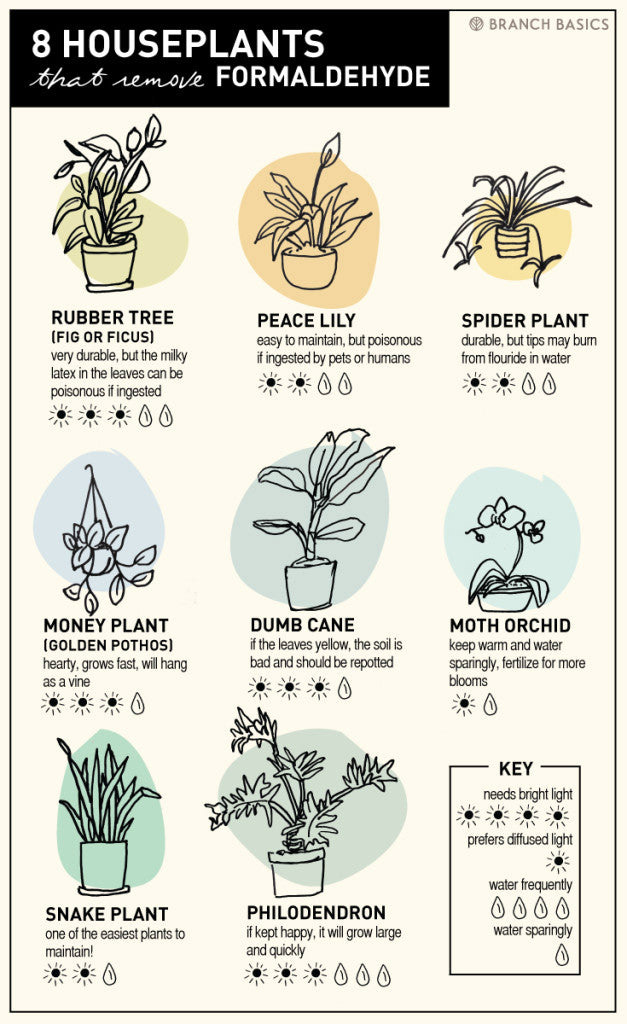
Source: Branch Basics – Here’s an example of an inforgraphic that simplified the complex idea of houseplants
2. Increase User Engagement and Message Retention
Visuals capture attention faster and hold it longer. Infographics significantly boost on-page engagement by reducing bounce rates and increasing time spent with your content. They also enhance memory recall, helping potential customers remember your brand and value long after they leave your site or other distribution channels.
Consider this for an example here. A well-designed infographic from a company like Zendesk on ‘Trends in Software CX’ will leave a lasting impression on the viewer. It also helps them remember the information and recall it later on.
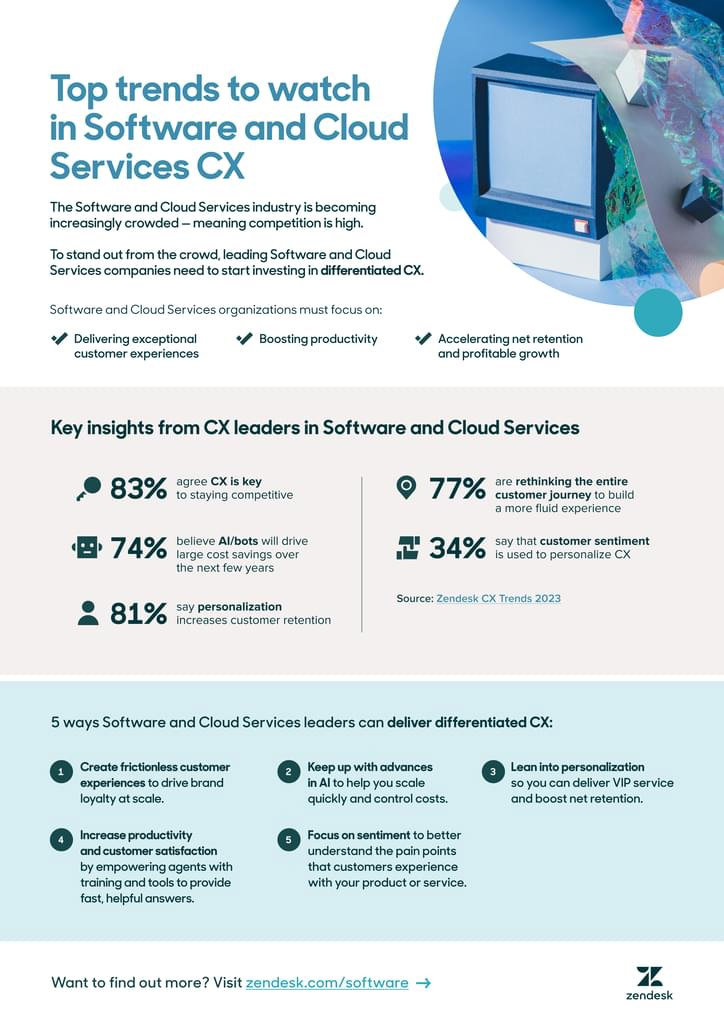
Source: Zendesk – This image shows an example of how highlighting statistics and number and make an infographic more presentable
3. Drive SEO Performance and Authority
High-quality infographics are shareable, link-worthy assets. When you publish informative or data-driven visuals, other sites and content creators are more likely to reference and link back to them. This helps in driving valuable backlinks that boost your SEO rankings. As they are optimized with alt tags and keywords, infographics can rank in image search, too.
Authoritative websites can link or include educational infographics within their blogs or content hubs, increasing authority for your business website. SEMrush’s infographics on improving content, SEO and keyword research are consistently referenced in other blogs or added within external content. This has helped enhance its authority further in the industry.
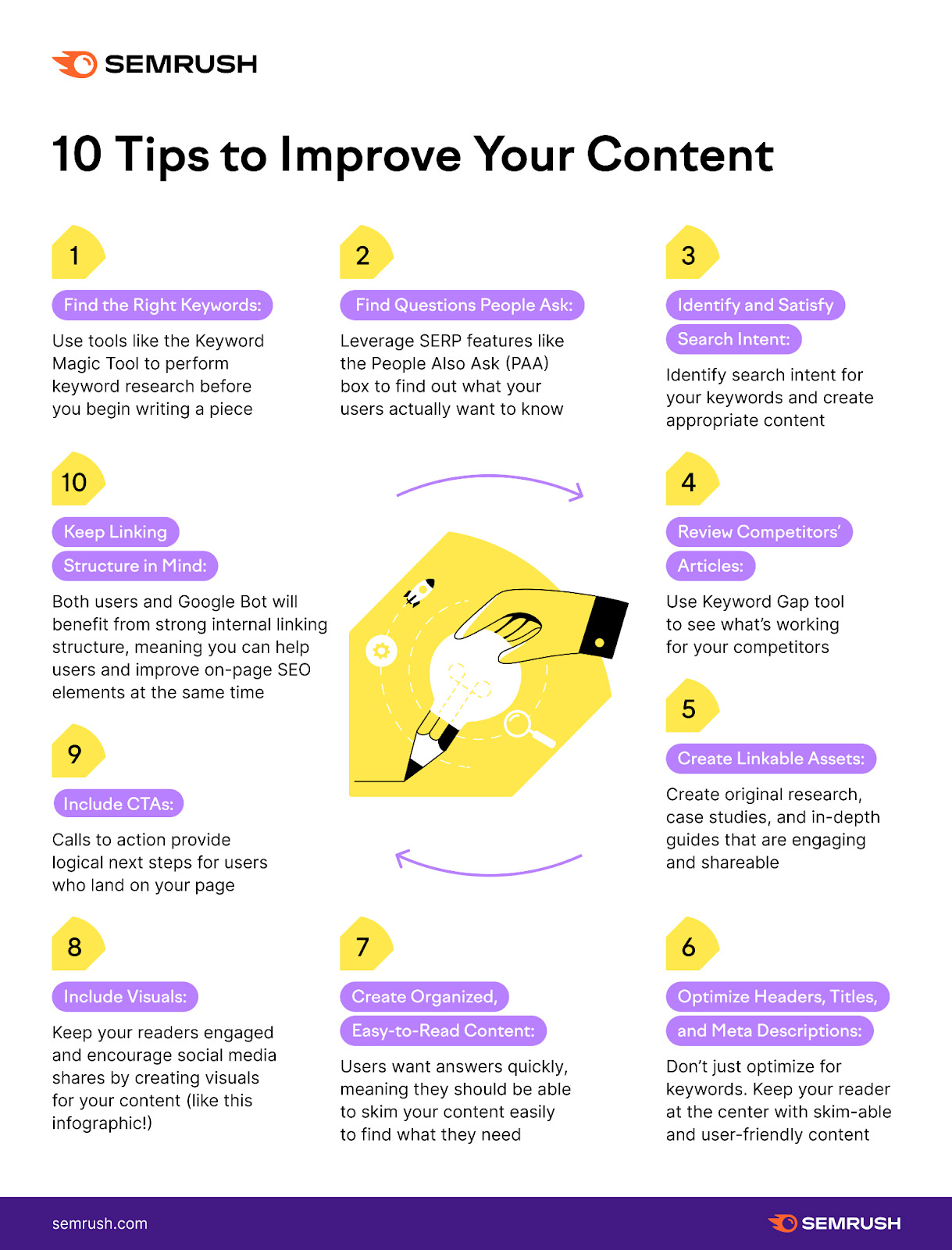
Source: SEMrush – This images shows an infographic example by Semrush to improve your content
4. Build Professionalism and Brand Trust
A well-designed infographic that reflects your brand’s visual identity, colors, fonts, tone, and logo builds trust and professionalism. It shows that your business cares about details and presents information in a clear way. Consistent branding across visuals helps increase brand familiarity among existing audiences and potential customers too. People will be more likely to consider your business credible if they see recognizable brand elements on infographics.
Prowly’s infographic on the press release structure is a good example here. It shows their expertise and breaks down the strategy into simple steps.
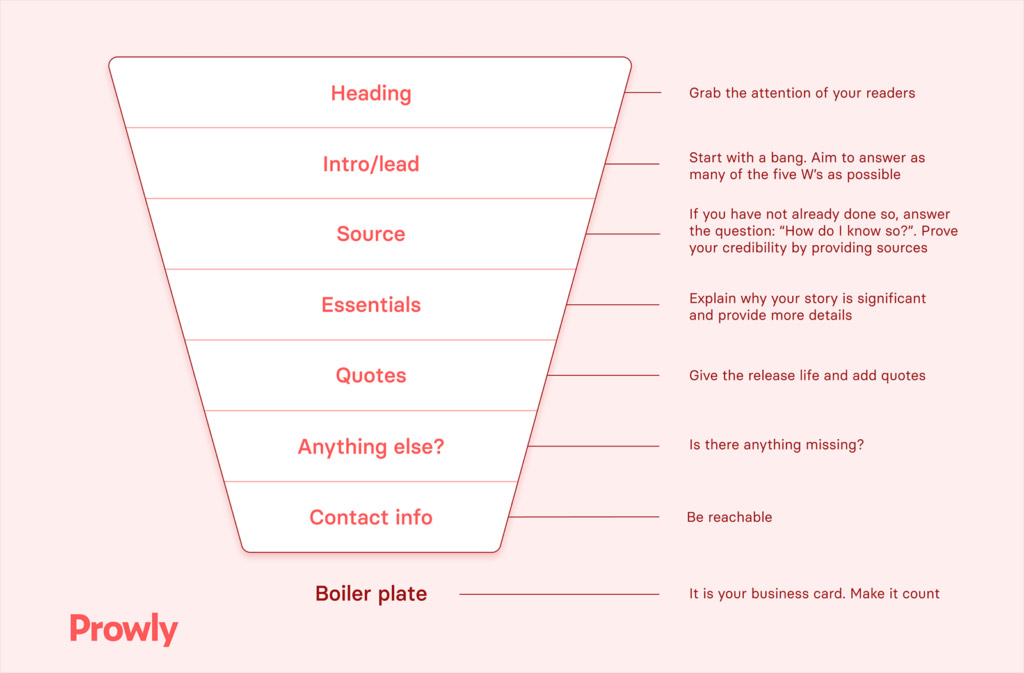
Source: Prowly – The images shows an example by Prowly using a press release structure
5. Boost Content Marketing Strategies
Infographics are one of the most efficient forms of repurposable content. A single infographic can be shared across social media, embedded in blogs, included in newsletters, added to presentations, and even printed as sales collateral. This multi-use flexibility means more visibility with less effort, making infographics quite valuable for small teams.
A visually appealing infographic, like the one on bycatch by Enasia highlights its impact on marine life. It can be shared across multiple platforms as valuable content and boost brand visibility.
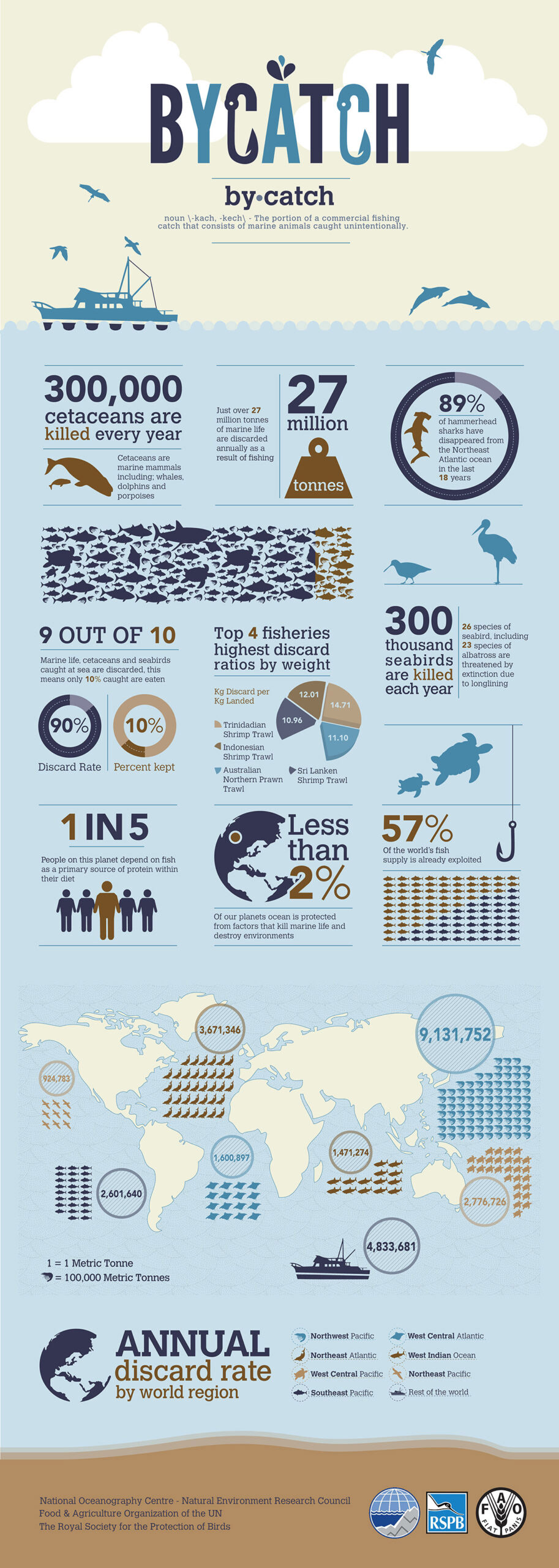
Source: Ensia – The images show Bycatch displaying it’s achievement in an infographic
6. Position Your Business as a Thought Leader
By sharing educational, research-based, or insightful infographics, your brand can showcase industry knowledge and establish a strong position in your niche. Visuals that share essential information can help your business gain credibility as a trusted voice, attracting attention from both potential customers and competitors.
The infographic created by the firefighter’s credit union does this exceptionally well. It includes tips for first-time home buyers that are engaging and provide memorable insights, too. This is one example of how infographics can help build audience trust and position your business as an expert. Another is CodeNest, which used infographics to communicate the company message to gain potential clients’ attention.

Source: Firefighter Community – This image by Firefighers Community displays tips for first time home buyers
7. Improve Conversion Rates Quickly
Infographics condense key information like product comparisons, pricing, or service benefits into visuals that are easy to scan and understand. This reduces bounce rates in the buying journey and encourages quicker decision-making. When used strategically on landing pages or in proposals, infographics can directly influence conversions and sales.
Patriot Software has created a simple infographic with tips on starting a business for potential customers or visitors looking to learn more about it. The content is easy to follow and includes well-designed visuals. It can help increase conversions as people would be more likely to find out more about the software and how it can help them in running their own businesses.
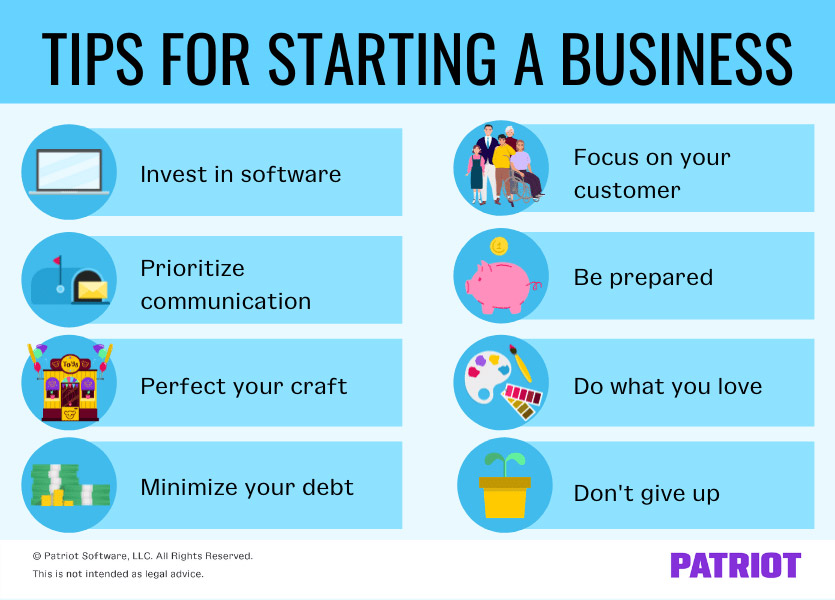
Source: Patriot Software – This image by Patriot shows the tips for starting a business
In the end, it is important to include infographics as part of your small business marketing strategy. They are incredibly effective for grabbing the attention of potential customers and increasing brand recall. Branded visuals that are informative will most likely bring people back to your website, social media page, or other mediums and result in higher conversions.
